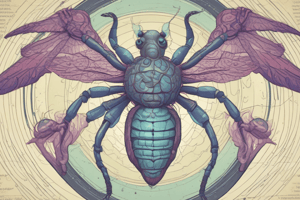Podcast
Questions and Answers
Which disease is transmitted by mosquitoes?
Which disease is transmitted by mosquitoes?
- Malaria (correct)
- Lyme disease
- Rocky Mountain spotted fever
- Anaplasmosis
What role do beetles and ants play in ecosystems?
What role do beetles and ants play in ecosystems?
- Pollinators
- Predators
- Decomposers (correct)
- Pathogen carriers
What is the primary function of the thorax in insects?
What is the primary function of the thorax in insects?
- Supports legs and wings (correct)
- Protects the exoskeleton
- Contains sensory organs
- Houses digestive organs
Which of the following statements about insect populations is true?
Which of the following statements about insect populations is true?
How do house flies contribute to public health issues?
How do house flies contribute to public health issues?
What is the main component of an insect's exoskeleton?
What is the main component of an insect's exoskeleton?
Which insects are known to provide significant pollination services?
Which insects are known to provide significant pollination services?
What feature of the insect respiratory system allows for direct gas exchange?
What feature of the insect respiratory system allows for direct gas exchange?
Flashcards are hidden until you start studying
Study Notes
Diseases Transmitted By Insects
- Vector-Borne Diseases: Insects act as vectors that transmit pathogens to humans and animals.
- Common Insect Vectors:
- Mosquitoes: Transmit diseases like malaria, dengue fever, Zika virus, and West Nile virus.
- Ticks: Carry Lyme disease, Rocky Mountain spotted fever, and anaplasmosis.
- Flies: House flies can transmit bacteria and viruses; tsetse flies transmit African sleeping sickness.
- Prevention Methods:
- Use of insect repellent
- Mosquito nets and screens
- Vaccinations where available
- Environmental control measures (removing standing water)
Insect Ecology
- Roles in Ecosystems:
- Pollinators: Many insects, like bees and butterflies, are crucial for pollinating plants.
- Decomposers: Insects like beetles and ants break down organic matter, recycling nutrients back into the soil.
- Food Source: Insects serve as a food source for various animals, including birds, mammals, and reptiles.
- Habitat Diversity:
- Insects thrive in almost every habitat, including forests, deserts, freshwater, and marine environments.
- They exhibit varied adaptations to their environments, influencing ecosystem dynamics.
- Population Dynamics:
- Factors affecting insect populations include predation, food availability, climate conditions, and habitat changes.
Insect Anatomy
- Body Structure:
- Three Main Parts: Head, thorax, abdomen.
- Head: Contains sensory organs (eyes, antennae) and mouthparts.
- Thorax: Houses legs (usually three pairs) and wings (if present).
- Abdomen: Contains digestive and reproductive organs.
- Three Main Parts: Head, thorax, abdomen.
- Exoskeleton:
- Made of chitin, providing protection and structural support.
- Allows for body segmentation and flexibility.
- Respiratory System:
- Tracheal system with spiracles for gas exchange, allowing direct oxygen transport to tissues.
- Circulatory System:
- Open circulatory system; hemolymph circulates through the body cavity.
- Nervous System:
- Consists of a brain and a ventral nerve cord with segmented ganglia controlling body movements and sensory input.
Diseases Transmitted By Insects
- Vector-borne diseases are transmitted by insects that serve as carriers of pathogens, affecting humans and animals.
- Common insect vectors include:
- Mosquitoes: Responsible for malaria, dengue fever, Zika virus, and West Nile virus transmission.
- Ticks: Transmit Lyme disease, Rocky Mountain spotted fever, and anaplasmosis.
- Flies: House flies can carry bacteria and viruses; tsetse flies are vectors for African sleeping sickness.
- Prevention methods include:
- Application of insect repellent.
- Use of mosquito nets and screens to reduce bites.
- Vaccinations when available to safeguard against specific diseases.
- Environmental control, including the removal of standing water to eliminate breeding sites.
Insect Ecology
- Insects play vital roles in ecosystems:
- Pollinators like bees and butterflies support plant reproduction.
- Decomposers such as beetles and ants recycle organic matter, enriching soil nutrients.
- Insects are a significant food source for birds, mammals, and reptiles.
- Habitat diversity:
- Insects are found in nearly all ecosystems, including forests, deserts, freshwater, and marine environments.
- They adapt to various habitats, impacting ecological dynamics.
- Population dynamics of insects are influenced by:
- Predation relationships with other species.
- Availability of food sources which can fluctuate.
- Climate conditions affecting survival and reproduction.
- Changes in habitat from environmental shifts.
Insect Anatomy
- Insects have a structured body divided into three main parts:
- Head: Contains sensory organs such as eyes and antennae, along with specialized mouthparts for feeding.
- Thorax: Houses three pairs of legs and, if present, wings, essential for movement.
- Abdomen: Contains digestive and reproductive systems.
- Exoskeleton is composed of chitin, providing protective coverage and structural integrity, allowing for body segmentation and flexibility.
- Respiratory system features:
- A tracheal system with spiracles that facilitate gas exchange, ensuring direct oxygen delivery to tissues.
- Circulatory system is open, with hemolymph circulating through the body cavity, delivering nutrients and removing waste.
- Nervous system consists of a brain and a ventral nerve cord with segmented ganglia, coordinating body movements and processing sensory information.
Studying That Suits You
Use AI to generate personalized quizzes and flashcards to suit your learning preferences.




